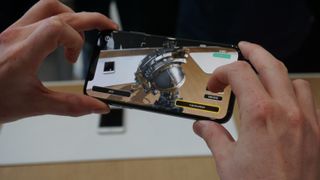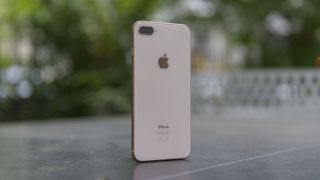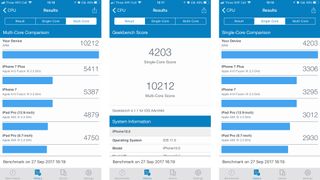iPhone 8 Plus vs iPhone X
The first difference here is cost - although not to the same level as vs the iPhone 8. The iPhone X starts at $999 / £999 / AU$1,579 if you want the 64GB model, where the iPhone 8 Plus begins at $799 / £799 / AU$1,229 for the same capacity.

So what are you getting for that (slightly) higher cost? Primarily, the screen - you've got a bezel-less 5.8-inch display with a 1,125 x 2,436 resolution, and it's OLED display technology too - that's superior to the 5.2-inch 1,080 x 1,920 screen on the iPhone 8.
That's a larger phone with a smaller screen - that's what losing the bezel brings.
The other big difference to consider is how you unlock this phone - with the iPhone 8 Plus, it's Touch ID fingerprint scanning, as it has been for years. With the iPhone X, you're unlocking with your face, using the nattily-named Face ID.
We are worried about whether Face ID will be swift and recognise faces fast enough - this will be one of the key things we look at in our review of the iPhone X when it lands.
The notch at the top of the iPhone X contains a camera that allows for Animoji, where emoji can be animated by mapping your face - this feature is locked to the iPhone X, and isn't a feature that appears on the iPhone 8 Plus or iPhone 8.
Both the iPhone X and iPhone 8 Plus have dual cameras , which allows for background de-focus and a more comprehensive photographic experience - however, due to the way the phones are packaged (to accommodate for the iPhone X notch) the camera array is horizontal on the X, but vertical on the 8 Plus.
Basically, the iPhone 8 Plus is the larger-screened version of the 8, with better battery and more heft.
The iPhone X is the next generation of Apple's phone. It's chock-full of new technology, it's exciting for Apple fans, but it's untested and expensive. Our full iPhone X review is incoming... so if you wanted to really find out which is best, we'd recommend waiting a few days.
iPhone 8 Plus price and release date
- Launch price (64GB): $799 / £799 / AU$1,229
- Launch price (256GB): $949 / £949 / AU$1,479
- Launched September 22, 2017
It’s probably no surprise to you, but the iPhone 8 Plus price is high – if you’re going for the 64GB model it’s $799 / £799 / AU$1,229, while the 256GB option comes in at $949 / £949 / AU$1,479.
There really needs to be a middle ground option for those who want to stick a few high-power apps on there, record a fair amount of video and download reams of music – that’s where a 128GB model would have fitted in nicely.
Advertisement
The average user might struggle to fill the 64GB variant with photos, apps and music, and it’s good to see that Apple is starting to get back ahead of how much storage most people need.
However, given that the iPhone 8 Plus can record in 4K at 60fps, and three minutes of that comes in at 2.16GB, if you’re going to do much filming at that quality you’ll fill the 64GB variant fairly easily.
The iPhone 8 Plus release date was September 22 – so if you’re looking to get your hands on one, you can do so now.
Glistening gold back offers new powers
- Glass back allows for wireless charging
- Looks luxurious in gold
The main thing you’ll notice about the iPhone 8 Plus from an aesthetic point of view is the outer coloring. The new gold version is the main event, with a gold aluminum rim and a gold/white glass back mixing together.
It’s a striking combination, and compared to the 7 Plus is really rather visually different, creating a more luxurious effect. The silver and space gray colors don’t quite have the same visual punch, but in the hand those phones still feel different with the glass back.
- iPhone 8 colors: what shades does it come in?
The reason for the glass back isn’t primarily aesthetic, though. Apple has finally jumped on the wireless charging bandwagon, just when it looked like it might be losing steam. Samsung has been the main promoter of the technology for the last couple of years, and now that Apple’s on board wireless charging is very likely to become mainstream.
There’s no denying it’s convenient, as popping your iPhone down on a charging pad is so much simpler than connecting and disconnecting a cable. But it’s hardly revolutionary – the tech has been baked into phones for years.

It would, perhaps, be more impactful here if there was a wireless charging pad in the box, but you’ll need to spend $59.95 / £54.95 / AU$99.95 to buy one from Mophie or Belkin right now, with Apple’s own AirPower pad coming later this year.
The speed of charging is impressive though, as it’s not too far off that of a wired connection. We can still remember the trickle charge you used to get with wireless, so you can see why Apple waited until the experience was good enough to put it in its handsets.
New Portrait Lighting mode
- Portrait mode is faster and better than before
- Portrait Lighting is a small but impressive new feature
The headline feature of the 12MP dual sensor on the rear camera is the enhanced bokeh mode – dubbed Portrait Lighting.
The abilities here are pretty astounding, and show how powerful the new A11 Bionic is inside – being able to algorithmically work out the contours of the face and change the lighting dynamically is impressive.
Advertisement
This can be done either while the picture is being taken or after, via the gallery – although while it’s a powerful tool, it’s not one that really impressed anyone we showed it to.
And that’s kind of indicative of the iPhone 8 Plus as a whole – while the overall experience is smoothed and enhanced, the headline features aren’t really there. Portrait Lighting is, well, fine – and we almost feel guilty for not evangelizing about it more, given how much intelligence has gone into creating it.
But taking a Portrait mode picture takes some setting up as it is – so achieving the level of quality where Portrait Lighting makes a big difference to the outcome is rare.
However, the new Portrait mode is one of the places where the iPhone 8 Plus is a significant upgrade over its predecessor – it’s brighter, faster to recognize the object you’re trying to snap, and it’s also got that Portrait Lighting feature, which isn’t coming to the older model.
The Portrait Lighting modes change things slightly, but nothing mega – and the Studio and Studio Mono modes look a little too cut-out, despite the edge detection being really accurate.
If you spend some time setting up a subject to take the perfect photo, you can get some decent results – but modern smartphone cameras need to take a brilliant quick snap, and we can see this feature being shunted off to the ‘rarely used’ section of your phone.
A11 Bionic engine
- Brilliant benchmark results
- Doesn't seem speedier in practice than 7 Plus or Note 8
It’s hard not to like the names Apple is appending to its chips these days. Following A10 Fusion, A11 Bionic doesn’t really make a lot of sense in terms of what it actually does, but it’s evocative.
Anyway – that’s that dealt with. The new chipset inside has six cores, with four efficient ones doing the basic stuff and the other two doing the heavy lifting, whether that’s photo-editing, intensive multi-tasking or providing real-time camera effects.
Those previously mentioned Portrait Lighting effects need some real power, and that’s where the A11 chip comes in. Any app that uses high levels of photo manipulation worked pretty flawlessly in our tests, with no lag when working with multiple image layers.
It’s hard to convey the usefulness of all this power for the average user, one who might not use such features regularly – but it’ll keep your iPhone singing more sweetly for the next two or three years compared to the previous generations.
Everything feels fast under the finger – although that seems like a redundant thing to say given that most iPhones feel that way when taken out of the box. The real test comes when you start loading it up with apps and content.

This is one of the most powerful phones out there
Generally, even when loaded up the iPhone was zippy as anything, with nothing flickering under the finger. However, we had a few moments where the interface juddered and bounced a bit – it still moved swiftly, but the frame rate slowed so it looked jagged.
It righted itself quickly, but it was surprising to note for an iPhone – it’s not something we’re used to.
What’s more surprising is that the iPhone 8 Plus didn’t perform any better in testing than the iPhone 7 Plus – we opened and closed apps on the two phones simultaneously, and the response times were identical - and was similar in performance to the Samsung Galaxy Note 8.
In fact, when saving a large video to Files, the iPhone 7 Plus was actually faster at completing the task, despite being older and having more storage taken up. The A11 Bionic chip is certainly powerful, but we’ve not seen anything that shows off the raw power in terms of regular interaction – it’s only evident in extra features like the Portrait Lighting.
In terms of out-and-out power though, this is the most powerful phone we’ve ever benchmarked. The Geekbench results are off the chart, powering past 10,000 for the multi-core score and easily beating anything from the Android world.
Will you notice the power of the iPhone in day-to-day use? Nope. iPhones have been rapid enough for years – but people are starting to expect even more and more from their device, whether that’s adding filters to photos, exporting content to friends, or playing the most powerful games around, and you’ll be glad of the bionic chip in a year’s time.
Apple doesn’t make a song and dance about the raw power in its devices, but it does build its reputation on phones just working as they should, and the iPhone 8 Plus will carry on working as it should longer than any phone Apple’s selling right now.








لا يوجد تعليقات
أضف تعليق